Impact of EHRs on Physician Productivity, Burnout, and Solutions
VerifiedAdded on 2021/04/17
|20
|4897
|37
Report
AI Summary
This report analyzes the impact of Electronic Health Records (EHRs) on physician productivity, provider burnout, and proposes solutions for the future. The study, based on thematic analysis of literature, explores how EHRs affect healthcare implications, physician burnout, and productivity. It highlights that while EHRs are beneficial, improper implementation can lead to increased documentation, regulatory requirements, and ultimately, physician burnout and dissatisfaction. The report discusses the methodology used, which included a literature search across databases like PubMed, Medline, and Embase, and identifies key themes related to EHRs' influence on healthcare, burnout, and productivity, and barriers to EHR acceptance. The findings suggest strategies to address these issues, aiming to improve the quality of care. The report concludes with recommendations for optimal EHR implementation, focusing on increasing physician productivity and enhancing patient care. It references several studies and reports to support the findings and recommendations.
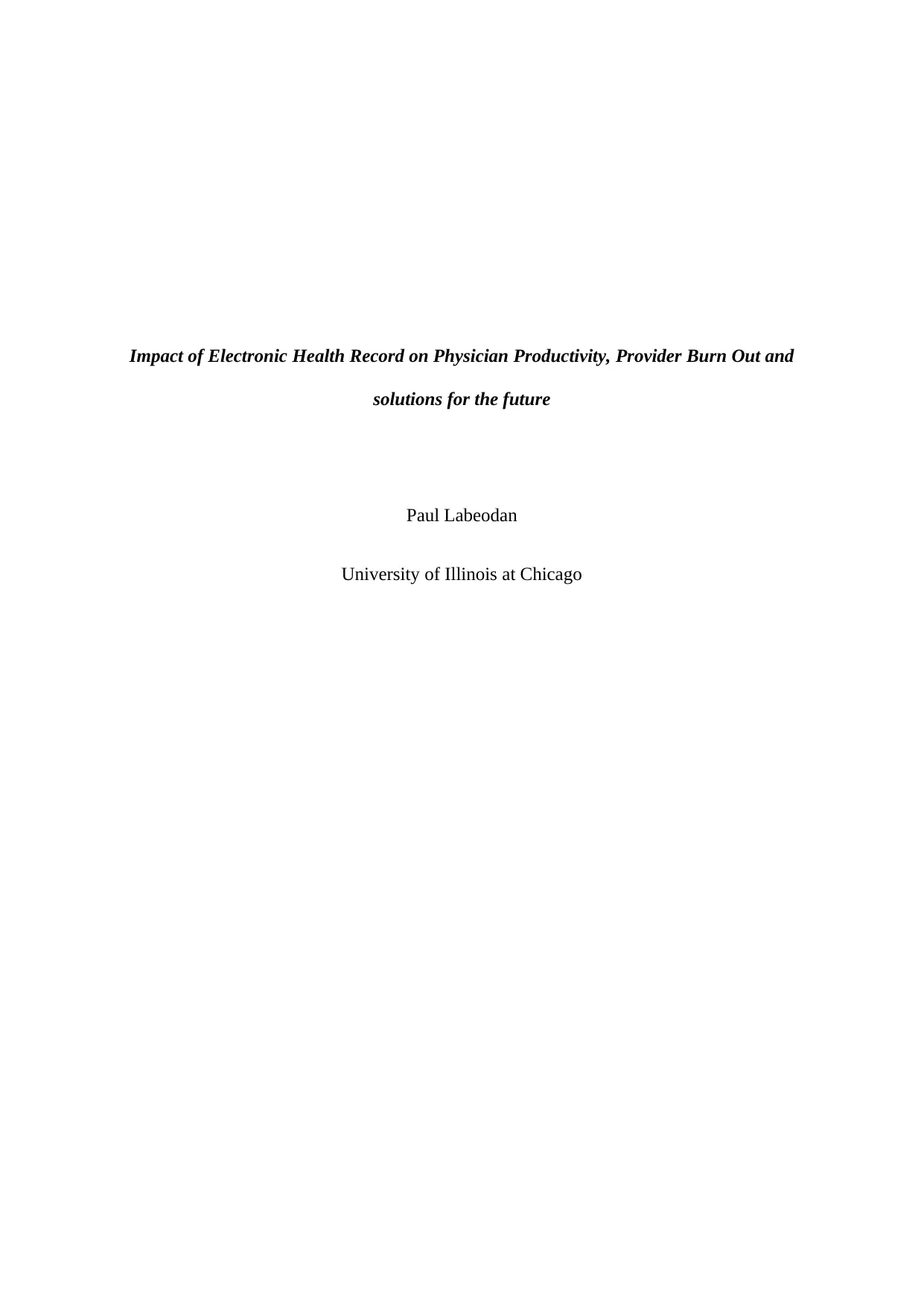
Impact of Electronic Health Record on Physician Productivity, Provider Burn Out and
solutions for the future
Paul Labeodan
University of Illinois at Chicago
solutions for the future
Paul Labeodan
University of Illinois at Chicago
Paraphrase This Document
Need a fresh take? Get an instant paraphrase of this document with our AI Paraphraser
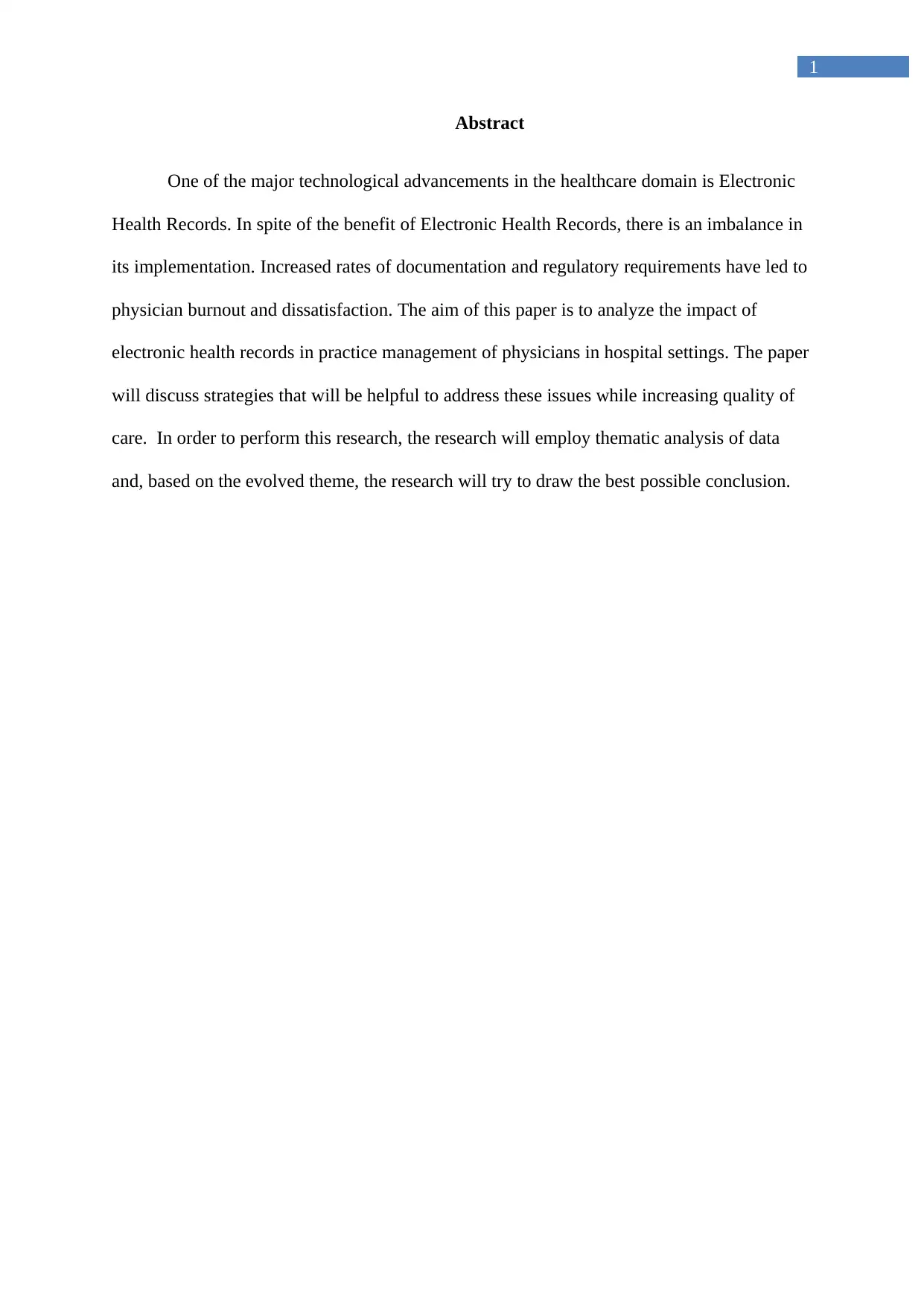
1
Abstract
One of the major technological advancements in the healthcare domain is Electronic
Health Records. In spite of the benefit of Electronic Health Records, there is an imbalance in
its implementation. Increased rates of documentation and regulatory requirements have led to
physician burnout and dissatisfaction. The aim of this paper is to analyze the impact of
electronic health records in practice management of physicians in hospital settings. The paper
will discuss strategies that will be helpful to address these issues while increasing quality of
care. In order to perform this research, the research will employ thematic analysis of data
and, based on the evolved theme, the research will try to draw the best possible conclusion.
Abstract
One of the major technological advancements in the healthcare domain is Electronic
Health Records. In spite of the benefit of Electronic Health Records, there is an imbalance in
its implementation. Increased rates of documentation and regulatory requirements have led to
physician burnout and dissatisfaction. The aim of this paper is to analyze the impact of
electronic health records in practice management of physicians in hospital settings. The paper
will discuss strategies that will be helpful to address these issues while increasing quality of
care. In order to perform this research, the research will employ thematic analysis of data
and, based on the evolved theme, the research will try to draw the best possible conclusion.
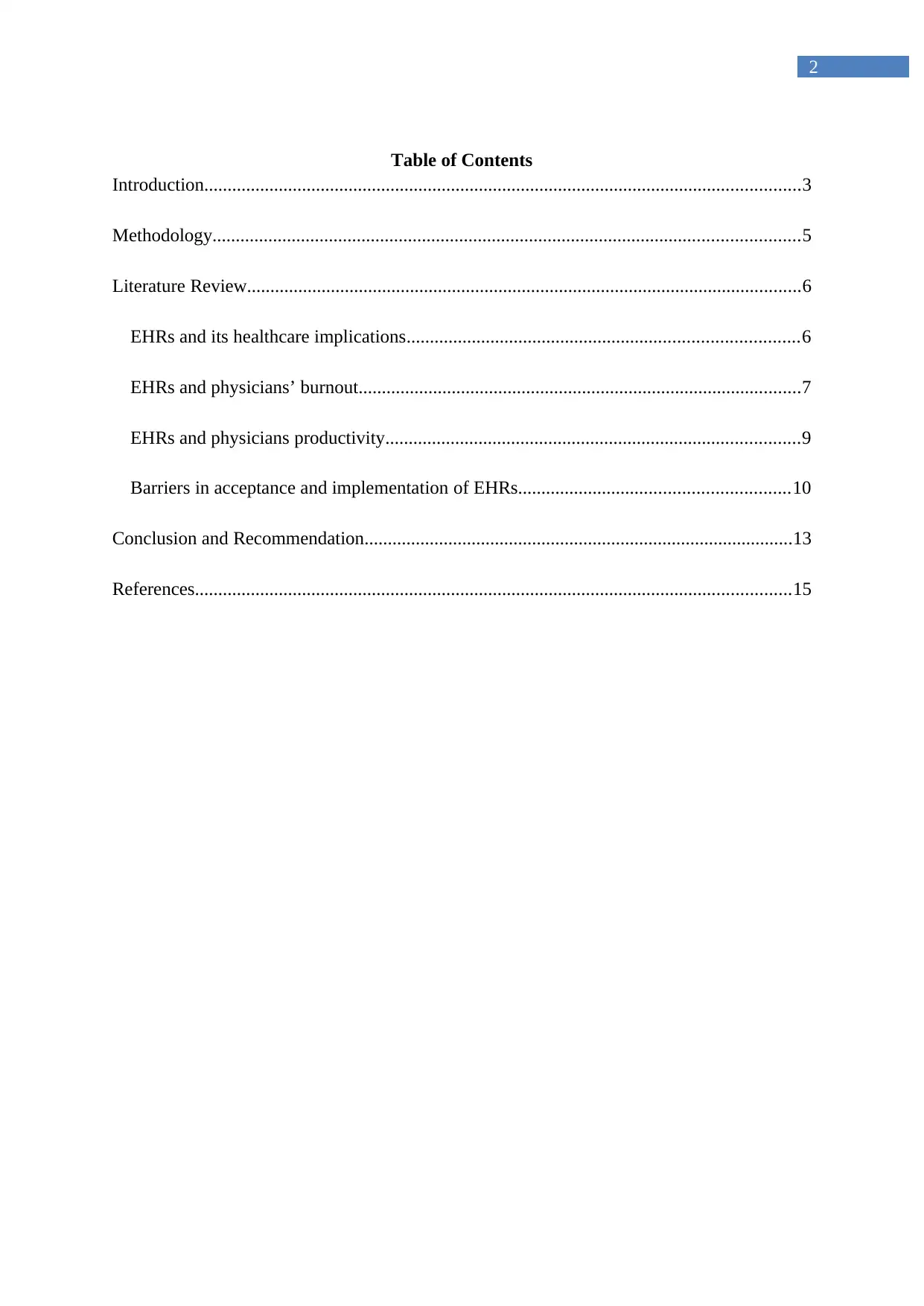
2
Table of Contents
Introduction................................................................................................................................3
Methodology..............................................................................................................................5
Literature Review.......................................................................................................................6
EHRs and its healthcare implications....................................................................................6
EHRs and physicians’ burnout...............................................................................................7
EHRs and physicians productivity.........................................................................................9
Barriers in acceptance and implementation of EHRs..........................................................10
Conclusion and Recommendation............................................................................................13
References................................................................................................................................15
Table of Contents
Introduction................................................................................................................................3
Methodology..............................................................................................................................5
Literature Review.......................................................................................................................6
EHRs and its healthcare implications....................................................................................6
EHRs and physicians’ burnout...............................................................................................7
EHRs and physicians productivity.........................................................................................9
Barriers in acceptance and implementation of EHRs..........................................................10
Conclusion and Recommendation............................................................................................13
References................................................................................................................................15
⊘ This is a preview!⊘
Do you want full access?
Subscribe today to unlock all pages.

Trusted by 1+ million students worldwide
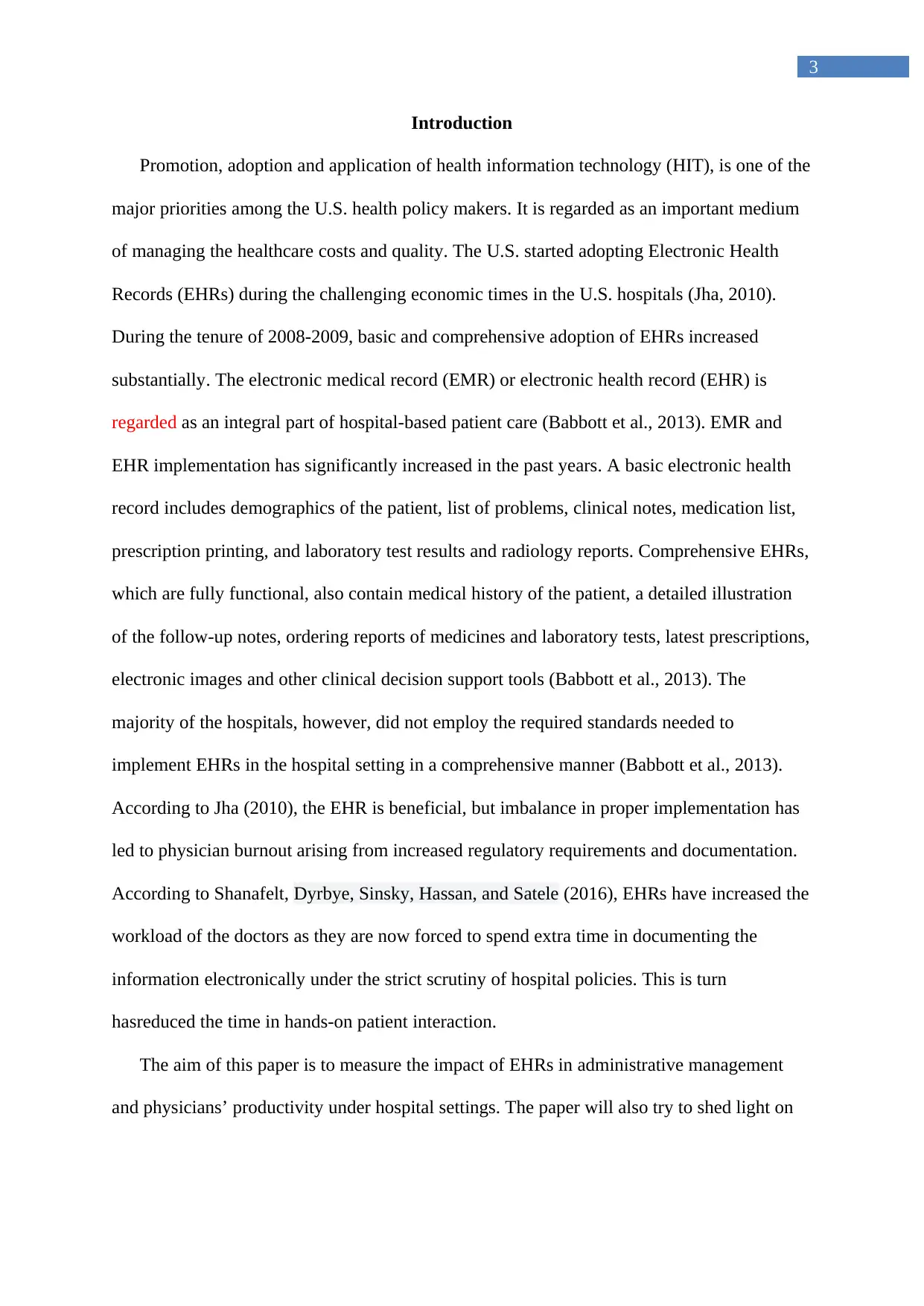
3
Introduction
Promotion, adoption and application of health information technology (HIT), is one of the
major priorities among the U.S. health policy makers. It is regarded as an important medium
of managing the healthcare costs and quality. The U.S. started adopting Electronic Health
Records (EHRs) during the challenging economic times in the U.S. hospitals (Jha, 2010).
During the tenure of 2008-2009, basic and comprehensive adoption of EHRs increased
substantially. The electronic medical record (EMR) or electronic health record (EHR) is
regarded as an integral part of hospital-based patient care (Babbott et al., 2013). EMR and
EHR implementation has significantly increased in the past years. A basic electronic health
record includes demographics of the patient, list of problems, clinical notes, medication list,
prescription printing, and laboratory test results and radiology reports. Comprehensive EHRs,
which are fully functional, also contain medical history of the patient, a detailed illustration
of the follow-up notes, ordering reports of medicines and laboratory tests, latest prescriptions,
electronic images and other clinical decision support tools (Babbott et al., 2013). The
majority of the hospitals, however, did not employ the required standards needed to
implement EHRs in the hospital setting in a comprehensive manner (Babbott et al., 2013).
According to Jha (2010), the EHR is beneficial, but imbalance in proper implementation has
led to physician burnout arising from increased regulatory requirements and documentation.
According to Shanafelt, Dyrbye, Sinsky, Hassan, and Satele (2016), EHRs have increased the
workload of the doctors as they are now forced to spend extra time in documenting the
information electronically under the strict scrutiny of hospital policies. This is turn
hasreduced the time in hands-on patient interaction.
The aim of this paper is to measure the impact of EHRs in administrative management
and physicians’ productivity under hospital settings. The paper will also try to shed light on
Introduction
Promotion, adoption and application of health information technology (HIT), is one of the
major priorities among the U.S. health policy makers. It is regarded as an important medium
of managing the healthcare costs and quality. The U.S. started adopting Electronic Health
Records (EHRs) during the challenging economic times in the U.S. hospitals (Jha, 2010).
During the tenure of 2008-2009, basic and comprehensive adoption of EHRs increased
substantially. The electronic medical record (EMR) or electronic health record (EHR) is
regarded as an integral part of hospital-based patient care (Babbott et al., 2013). EMR and
EHR implementation has significantly increased in the past years. A basic electronic health
record includes demographics of the patient, list of problems, clinical notes, medication list,
prescription printing, and laboratory test results and radiology reports. Comprehensive EHRs,
which are fully functional, also contain medical history of the patient, a detailed illustration
of the follow-up notes, ordering reports of medicines and laboratory tests, latest prescriptions,
electronic images and other clinical decision support tools (Babbott et al., 2013). The
majority of the hospitals, however, did not employ the required standards needed to
implement EHRs in the hospital setting in a comprehensive manner (Babbott et al., 2013).
According to Jha (2010), the EHR is beneficial, but imbalance in proper implementation has
led to physician burnout arising from increased regulatory requirements and documentation.
According to Shanafelt, Dyrbye, Sinsky, Hassan, and Satele (2016), EHRs have increased the
workload of the doctors as they are now forced to spend extra time in documenting the
information electronically under the strict scrutiny of hospital policies. This is turn
hasreduced the time in hands-on patient interaction.
The aim of this paper is to measure the impact of EHRs in administrative management
and physicians’ productivity under hospital settings. The paper will also try to shed light on
Paraphrase This Document
Need a fresh take? Get an instant paraphrase of this document with our AI Paraphraser
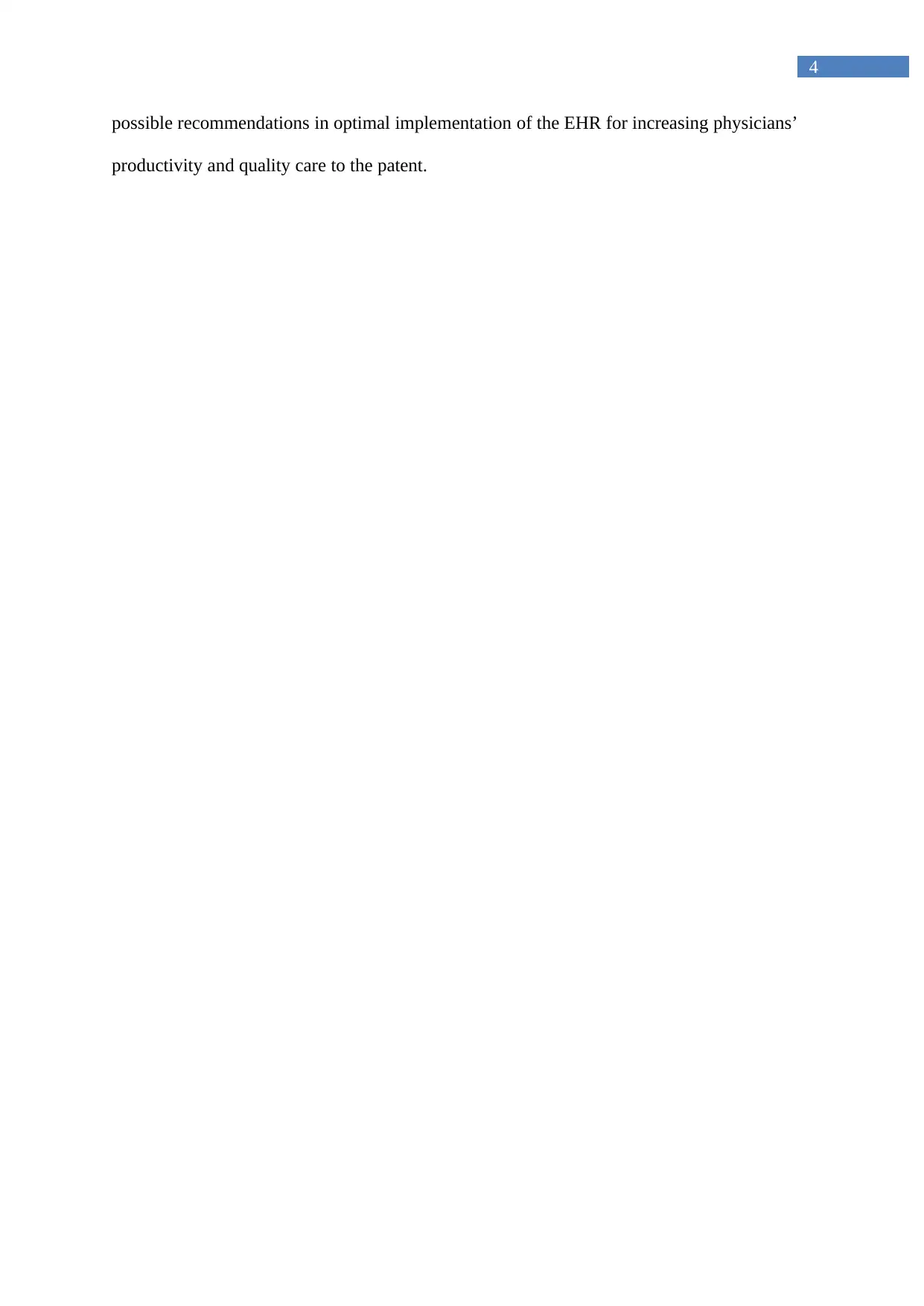
4
possible recommendations in optimal implementation of the EHR for increasing physicians’
productivity and quality care to the patent.
possible recommendations in optimal implementation of the EHR for increasing physicians’
productivity and quality care to the patent.

5
Methodology
The search of the literature was done in the databases PubMed, Medline and Embase
(from 2010 to 2018). The literature search was based on the use of broad keywords. The main
keywords used for the Boolean literature search include electronic health records (EHRs),
electronic medical records (EMRs), EHRs AND physician burnout OR physician
productivity, EHRs AND application, EHRs AND impact, EHRs AND barriers, EHRs AND
application, EHRs AND patient. The main inclusion criteria included for the search of the
research articles included studies that were published on or after 2010 and are available in
English. The search was not limited by size of the trial and type. The studies dealing with the
genetic studies in association with EMRs or EHRs, mobile-based encryption, role of
information technology in EMRs and EHRs were excluded from the search since those were
out of scope of the aim of the research. In the inclusion criteria, surveys, systematic reviews
and meta-analysis were chosen because aim of this review is to provide a comprehensive
picture of EMRs or EHRs in holistic patient care and physician burnout.
Methodology
The search of the literature was done in the databases PubMed, Medline and Embase
(from 2010 to 2018). The literature search was based on the use of broad keywords. The main
keywords used for the Boolean literature search include electronic health records (EHRs),
electronic medical records (EMRs), EHRs AND physician burnout OR physician
productivity, EHRs AND application, EHRs AND impact, EHRs AND barriers, EHRs AND
application, EHRs AND patient. The main inclusion criteria included for the search of the
research articles included studies that were published on or after 2010 and are available in
English. The search was not limited by size of the trial and type. The studies dealing with the
genetic studies in association with EMRs or EHRs, mobile-based encryption, role of
information technology in EMRs and EHRs were excluded from the search since those were
out of scope of the aim of the research. In the inclusion criteria, surveys, systematic reviews
and meta-analysis were chosen because aim of this review is to provide a comprehensive
picture of EMRs or EHRs in holistic patient care and physician burnout.
⊘ This is a preview!⊘
Do you want full access?
Subscribe today to unlock all pages.

Trusted by 1+ million students worldwide

6
Results
The keyword search identified 100 papers. These papers were again scrutinized based
on the title of the research and 50 articles were found to be significant. These 50 papers were
again reviewed based on their abstract and out of those, 30 were found relevant. These 30
research papers were read thoroughly and only 20 papers coincided with the scope of the
review. Study of the research papers led to the generation of four themes. These themes will
help to generate a comprehensive scenario of EMRs or EHRs.
EHRs and their Healthcare Implications
The Health Information Technology for Economic and Clinical Health (HITECH) Act
of 2009 was passed in order to support the diffusion of health information technology
towards improvement of patient care. HITECH then established national EHRs certification
campaign to certify the capacity of EHRs to satisfy the meaningful use requirements of
healthcare systems (King, Patel, Jamoom & Furukawa, 2014).EHRS are now increasingly
becoming a popular medium for accessing patient’s health-related information (Haas,
Wohlgemuth, Echizen, Sonehara, & Müller, 2011). The survey conducted by King et al.
(2014) showed that 8 out of 10 physicians were satisfied with the application of EHRs
towards enhanced care. The majority of the physician who took part in the survey (81%)
reported that use of EHRs helped them to access the detailed health history of the patients
remotely. Nearly 65% physicians opined that application of EHRs alerted them to potential
medical error. Of the physicians surveyed, 62% believed that EHRs helped alert them to
critical laboratory values while providing clinical benefits (King, et al., 2014).Bowman
(2013) opined that clinical decision-making supported by EHRs results in errors. These errors
arise out of system performance issues, software design flaws, poor decision support rules
and inadequate user training. Application of decision support systems may generate errors of
Results
The keyword search identified 100 papers. These papers were again scrutinized based
on the title of the research and 50 articles were found to be significant. These 50 papers were
again reviewed based on their abstract and out of those, 30 were found relevant. These 30
research papers were read thoroughly and only 20 papers coincided with the scope of the
review. Study of the research papers led to the generation of four themes. These themes will
help to generate a comprehensive scenario of EMRs or EHRs.
EHRs and their Healthcare Implications
The Health Information Technology for Economic and Clinical Health (HITECH) Act
of 2009 was passed in order to support the diffusion of health information technology
towards improvement of patient care. HITECH then established national EHRs certification
campaign to certify the capacity of EHRs to satisfy the meaningful use requirements of
healthcare systems (King, Patel, Jamoom & Furukawa, 2014).EHRS are now increasingly
becoming a popular medium for accessing patient’s health-related information (Haas,
Wohlgemuth, Echizen, Sonehara, & Müller, 2011). The survey conducted by King et al.
(2014) showed that 8 out of 10 physicians were satisfied with the application of EHRs
towards enhanced care. The majority of the physician who took part in the survey (81%)
reported that use of EHRs helped them to access the detailed health history of the patients
remotely. Nearly 65% physicians opined that application of EHRs alerted them to potential
medical error. Of the physicians surveyed, 62% believed that EHRs helped alert them to
critical laboratory values while providing clinical benefits (King, et al., 2014).Bowman
(2013) opined that clinical decision-making supported by EHRs results in errors. These errors
arise out of system performance issues, software design flaws, poor decision support rules
and inadequate user training. Application of decision support systems may generate errors of
Paraphrase This Document
Need a fresh take? Get an instant paraphrase of this document with our AI Paraphraser
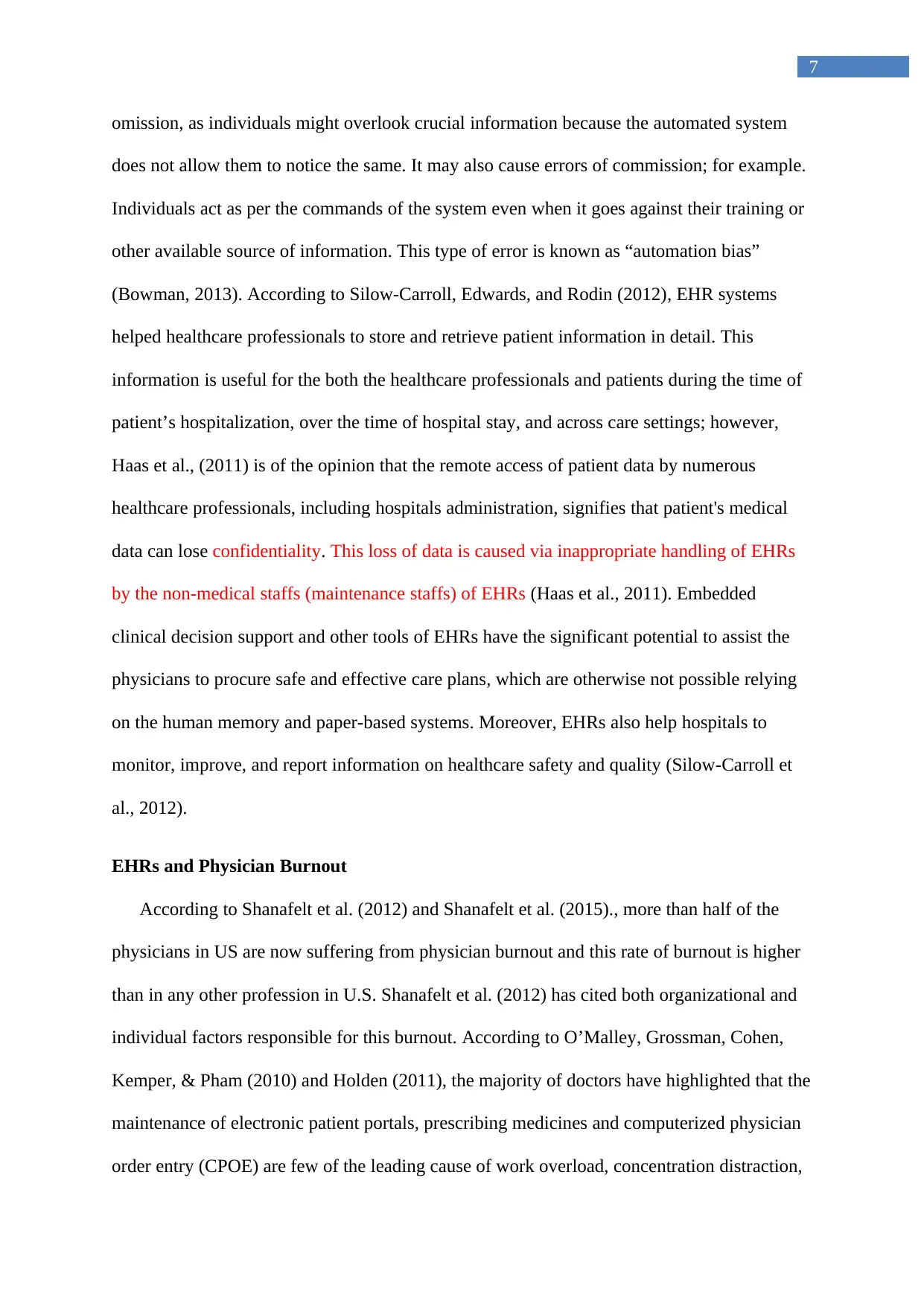
7
omission, as individuals might overlook crucial information because the automated system
does not allow them to notice the same. It may also cause errors of commission; for example.
Individuals act as per the commands of the system even when it goes against their training or
other available source of information. This type of error is known as “automation bias”
(Bowman, 2013). According to Silow-Carroll, Edwards, and Rodin (2012), EHR systems
helped healthcare professionals to store and retrieve patient information in detail. This
information is useful for the both the healthcare professionals and patients during the time of
patient’s hospitalization, over the time of hospital stay, and across care settings; however,
Haas et al., (2011) is of the opinion that the remote access of patient data by numerous
healthcare professionals, including hospitals administration, signifies that patient's medical
data can lose confidentiality. This loss of data is caused via inappropriate handling of EHRs
by the non-medical staffs (maintenance staffs) of EHRs (Haas et al., 2011). Embedded
clinical decision support and other tools of EHRs have the significant potential to assist the
physicians to procure safe and effective care plans, which are otherwise not possible relying
on the human memory and paper-based systems. Moreover, EHRs also help hospitals to
monitor, improve, and report information on healthcare safety and quality (Silow-Carroll et
al., 2012).
EHRs and Physician Burnout
According to Shanafelt et al. (2012) and Shanafelt et al. (2015)., more than half of the
physicians in US are now suffering from physician burnout and this rate of burnout is higher
than in any other profession in U.S. Shanafelt et al. (2012) has cited both organizational and
individual factors responsible for this burnout. According to O’Malley, Grossman, Cohen,
Kemper, & Pham (2010) and Holden (2011), the majority of doctors have highlighted that the
maintenance of electronic patient portals, prescribing medicines and computerized physician
order entry (CPOE) are few of the leading cause of work overload, concentration distraction,
omission, as individuals might overlook crucial information because the automated system
does not allow them to notice the same. It may also cause errors of commission; for example.
Individuals act as per the commands of the system even when it goes against their training or
other available source of information. This type of error is known as “automation bias”
(Bowman, 2013). According to Silow-Carroll, Edwards, and Rodin (2012), EHR systems
helped healthcare professionals to store and retrieve patient information in detail. This
information is useful for the both the healthcare professionals and patients during the time of
patient’s hospitalization, over the time of hospital stay, and across care settings; however,
Haas et al., (2011) is of the opinion that the remote access of patient data by numerous
healthcare professionals, including hospitals administration, signifies that patient's medical
data can lose confidentiality. This loss of data is caused via inappropriate handling of EHRs
by the non-medical staffs (maintenance staffs) of EHRs (Haas et al., 2011). Embedded
clinical decision support and other tools of EHRs have the significant potential to assist the
physicians to procure safe and effective care plans, which are otherwise not possible relying
on the human memory and paper-based systems. Moreover, EHRs also help hospitals to
monitor, improve, and report information on healthcare safety and quality (Silow-Carroll et
al., 2012).
EHRs and Physician Burnout
According to Shanafelt et al. (2012) and Shanafelt et al. (2015)., more than half of the
physicians in US are now suffering from physician burnout and this rate of burnout is higher
than in any other profession in U.S. Shanafelt et al. (2012) has cited both organizational and
individual factors responsible for this burnout. According to O’Malley, Grossman, Cohen,
Kemper, & Pham (2010) and Holden (2011), the majority of doctors have highlighted that the
maintenance of electronic patient portals, prescribing medicines and computerized physician
order entry (CPOE) are few of the leading cause of work overload, concentration distraction,
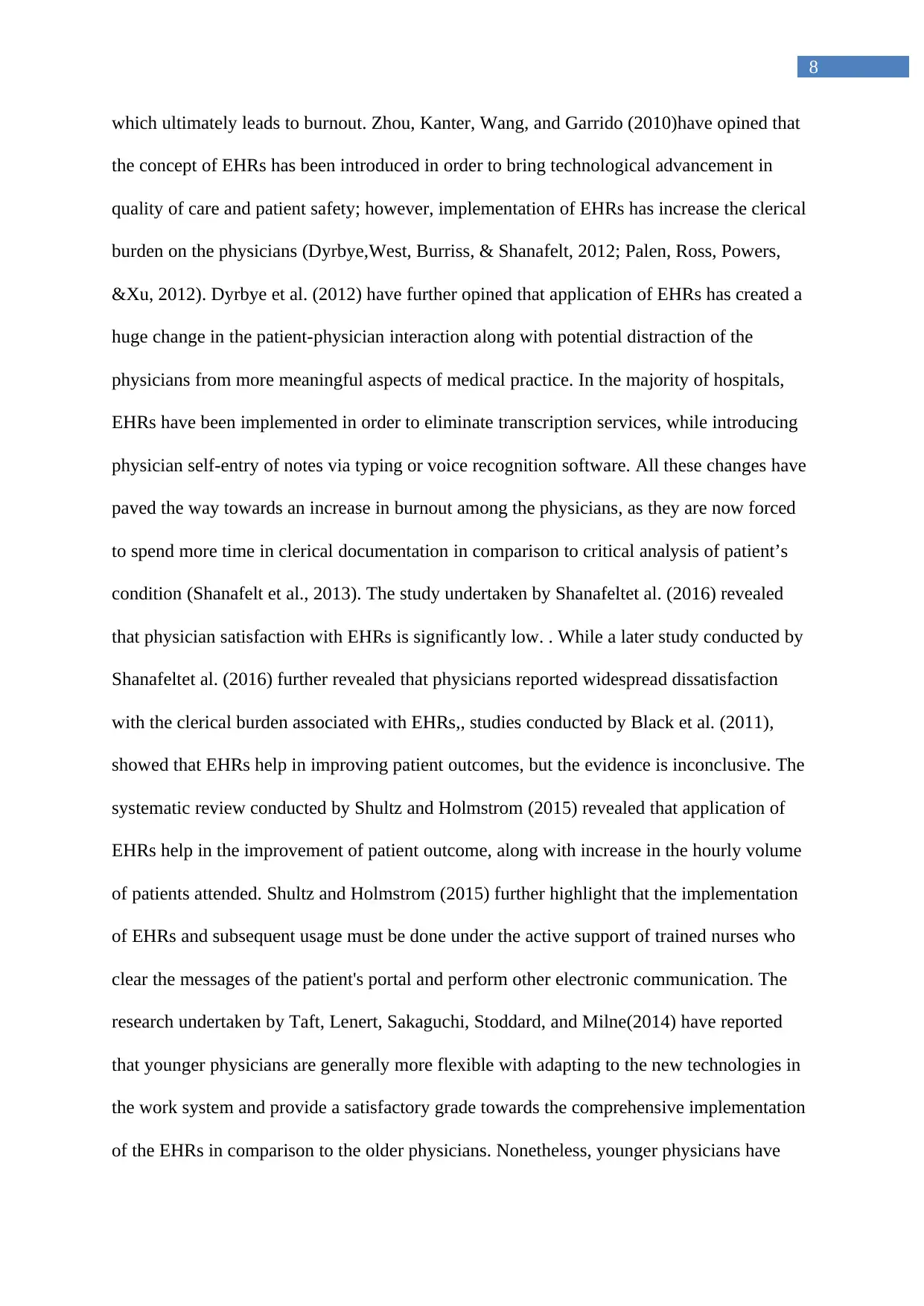
8
which ultimately leads to burnout. Zhou, Kanter, Wang, and Garrido (2010)have opined that
the concept of EHRs has been introduced in order to bring technological advancement in
quality of care and patient safety; however, implementation of EHRs has increase the clerical
burden on the physicians (Dyrbye,West, Burriss, & Shanafelt, 2012; Palen, Ross, Powers,
&Xu, 2012). Dyrbye et al. (2012) have further opined that application of EHRs has created a
huge change in the patient-physician interaction along with potential distraction of the
physicians from more meaningful aspects of medical practice. In the majority of hospitals,
EHRs have been implemented in order to eliminate transcription services, while introducing
physician self-entry of notes via typing or voice recognition software. All these changes have
paved the way towards an increase in burnout among the physicians, as they are now forced
to spend more time in clerical documentation in comparison to critical analysis of patient’s
condition (Shanafelt et al., 2013). The study undertaken by Shanafeltet al. (2016) revealed
that physician satisfaction with EHRs is significantly low. . While a later study conducted by
Shanafeltet al. (2016) further revealed that physicians reported widespread dissatisfaction
with the clerical burden associated with EHRs,, studies conducted by Black et al. (2011),
showed that EHRs help in improving patient outcomes, but the evidence is inconclusive. The
systematic review conducted by Shultz and Holmstrom (2015) revealed that application of
EHRs help in the improvement of patient outcome, along with increase in the hourly volume
of patients attended. Shultz and Holmstrom (2015) further highlight that the implementation
of EHRs and subsequent usage must be done under the active support of trained nurses who
clear the messages of the patient's portal and perform other electronic communication. The
research undertaken by Taft, Lenert, Sakaguchi, Stoddard, and Milne(2014) have reported
that younger physicians are generally more flexible with adapting to the new technologies in
the work system and provide a satisfactory grade towards the comprehensive implementation
of the EHRs in comparison to the older physicians. Nonetheless, younger physicians have
which ultimately leads to burnout. Zhou, Kanter, Wang, and Garrido (2010)have opined that
the concept of EHRs has been introduced in order to bring technological advancement in
quality of care and patient safety; however, implementation of EHRs has increase the clerical
burden on the physicians (Dyrbye,West, Burriss, & Shanafelt, 2012; Palen, Ross, Powers,
&Xu, 2012). Dyrbye et al. (2012) have further opined that application of EHRs has created a
huge change in the patient-physician interaction along with potential distraction of the
physicians from more meaningful aspects of medical practice. In the majority of hospitals,
EHRs have been implemented in order to eliminate transcription services, while introducing
physician self-entry of notes via typing or voice recognition software. All these changes have
paved the way towards an increase in burnout among the physicians, as they are now forced
to spend more time in clerical documentation in comparison to critical analysis of patient’s
condition (Shanafelt et al., 2013). The study undertaken by Shanafeltet al. (2016) revealed
that physician satisfaction with EHRs is significantly low. . While a later study conducted by
Shanafeltet al. (2016) further revealed that physicians reported widespread dissatisfaction
with the clerical burden associated with EHRs,, studies conducted by Black et al. (2011),
showed that EHRs help in improving patient outcomes, but the evidence is inconclusive. The
systematic review conducted by Shultz and Holmstrom (2015) revealed that application of
EHRs help in the improvement of patient outcome, along with increase in the hourly volume
of patients attended. Shultz and Holmstrom (2015) further highlight that the implementation
of EHRs and subsequent usage must be done under the active support of trained nurses who
clear the messages of the patient's portal and perform other electronic communication. The
research undertaken by Taft, Lenert, Sakaguchi, Stoddard, and Milne(2014) have reported
that younger physicians are generally more flexible with adapting to the new technologies in
the work system and provide a satisfactory grade towards the comprehensive implementation
of the EHRs in comparison to the older physicians. Nonetheless, younger physicians have
⊘ This is a preview!⊘
Do you want full access?
Subscribe today to unlock all pages.

Trusted by 1+ million students worldwide
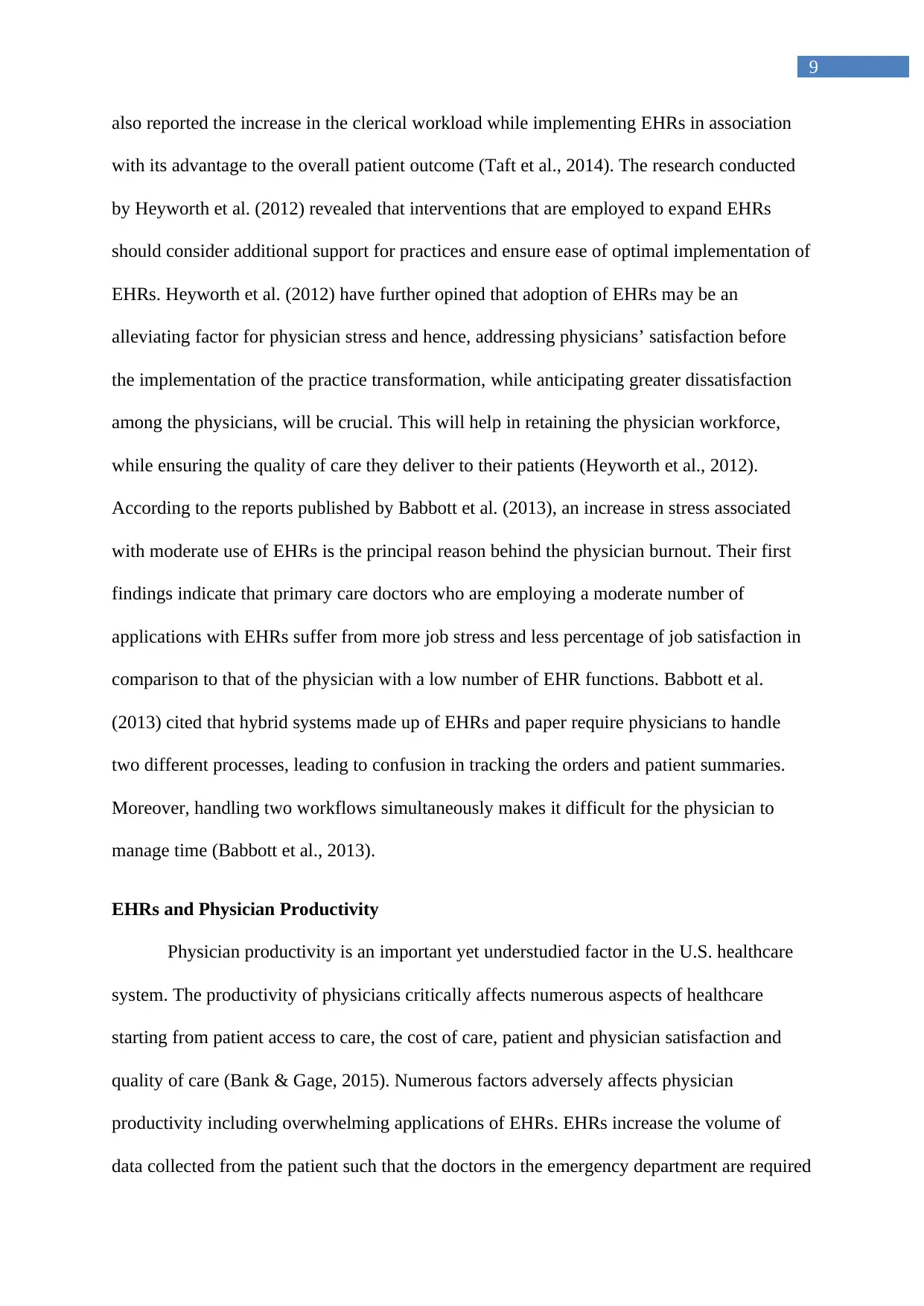
9
also reported the increase in the clerical workload while implementing EHRs in association
with its advantage to the overall patient outcome (Taft et al., 2014). The research conducted
by Heyworth et al. (2012) revealed that interventions that are employed to expand EHRs
should consider additional support for practices and ensure ease of optimal implementation of
EHRs. Heyworth et al. (2012) have further opined that adoption of EHRs may be an
alleviating factor for physician stress and hence, addressing physicians’ satisfaction before
the implementation of the practice transformation, while anticipating greater dissatisfaction
among the physicians, will be crucial. This will help in retaining the physician workforce,
while ensuring the quality of care they deliver to their patients (Heyworth et al., 2012).
According to the reports published by Babbott et al. (2013), an increase in stress associated
with moderate use of EHRs is the principal reason behind the physician burnout. Their first
findings indicate that primary care doctors who are employing a moderate number of
applications with EHRs suffer from more job stress and less percentage of job satisfaction in
comparison to that of the physician with a low number of EHR functions. Babbott et al.
(2013) cited that hybrid systems made up of EHRs and paper require physicians to handle
two different processes, leading to confusion in tracking the orders and patient summaries.
Moreover, handling two workflows simultaneously makes it difficult for the physician to
manage time (Babbott et al., 2013).
EHRs and Physician Productivity
Physician productivity is an important yet understudied factor in the U.S. healthcare
system. The productivity of physicians critically affects numerous aspects of healthcare
starting from patient access to care, the cost of care, patient and physician satisfaction and
quality of care (Bank & Gage, 2015). Numerous factors adversely affects physician
productivity including overwhelming applications of EHRs. EHRs increase the volume of
data collected from the patient such that the doctors in the emergency department are required
also reported the increase in the clerical workload while implementing EHRs in association
with its advantage to the overall patient outcome (Taft et al., 2014). The research conducted
by Heyworth et al. (2012) revealed that interventions that are employed to expand EHRs
should consider additional support for practices and ensure ease of optimal implementation of
EHRs. Heyworth et al. (2012) have further opined that adoption of EHRs may be an
alleviating factor for physician stress and hence, addressing physicians’ satisfaction before
the implementation of the practice transformation, while anticipating greater dissatisfaction
among the physicians, will be crucial. This will help in retaining the physician workforce,
while ensuring the quality of care they deliver to their patients (Heyworth et al., 2012).
According to the reports published by Babbott et al. (2013), an increase in stress associated
with moderate use of EHRs is the principal reason behind the physician burnout. Their first
findings indicate that primary care doctors who are employing a moderate number of
applications with EHRs suffer from more job stress and less percentage of job satisfaction in
comparison to that of the physician with a low number of EHR functions. Babbott et al.
(2013) cited that hybrid systems made up of EHRs and paper require physicians to handle
two different processes, leading to confusion in tracking the orders and patient summaries.
Moreover, handling two workflows simultaneously makes it difficult for the physician to
manage time (Babbott et al., 2013).
EHRs and Physician Productivity
Physician productivity is an important yet understudied factor in the U.S. healthcare
system. The productivity of physicians critically affects numerous aspects of healthcare
starting from patient access to care, the cost of care, patient and physician satisfaction and
quality of care (Bank & Gage, 2015). Numerous factors adversely affects physician
productivity including overwhelming applications of EHRs. EHRs increase the volume of
data collected from the patient such that the doctors in the emergency department are required
Paraphrase This Document
Need a fresh take? Get an instant paraphrase of this document with our AI Paraphraser
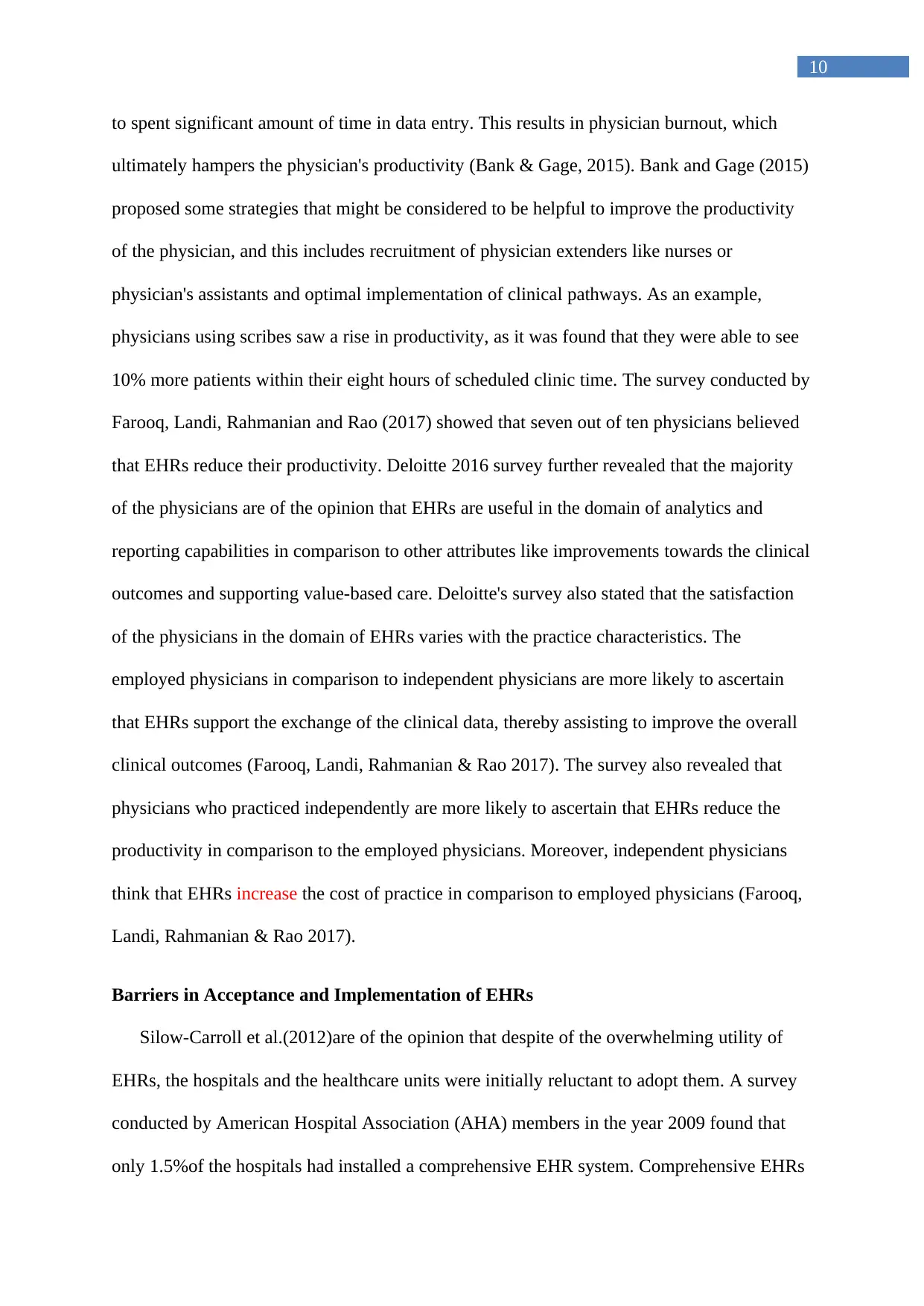
10
to spent significant amount of time in data entry. This results in physician burnout, which
ultimately hampers the physician's productivity (Bank & Gage, 2015). Bank and Gage (2015)
proposed some strategies that might be considered to be helpful to improve the productivity
of the physician, and this includes recruitment of physician extenders like nurses or
physician's assistants and optimal implementation of clinical pathways. As an example,
physicians using scribes saw a rise in productivity, as it was found that they were able to see
10% more patients within their eight hours of scheduled clinic time. The survey conducted by
Farooq, Landi, Rahmanian and Rao (2017) showed that seven out of ten physicians believed
that EHRs reduce their productivity. Deloitte 2016 survey further revealed that the majority
of the physicians are of the opinion that EHRs are useful in the domain of analytics and
reporting capabilities in comparison to other attributes like improvements towards the clinical
outcomes and supporting value-based care. Deloitte's survey also stated that the satisfaction
of the physicians in the domain of EHRs varies with the practice characteristics. The
employed physicians in comparison to independent physicians are more likely to ascertain
that EHRs support the exchange of the clinical data, thereby assisting to improve the overall
clinical outcomes (Farooq, Landi, Rahmanian & Rao 2017). The survey also revealed that
physicians who practiced independently are more likely to ascertain that EHRs reduce the
productivity in comparison to the employed physicians. Moreover, independent physicians
think that EHRs increase the cost of practice in comparison to employed physicians (Farooq,
Landi, Rahmanian & Rao 2017).
Barriers in Acceptance and Implementation of EHRs
Silow-Carroll et al.(2012)are of the opinion that despite of the overwhelming utility of
EHRs, the hospitals and the healthcare units were initially reluctant to adopt them. A survey
conducted by American Hospital Association (AHA) members in the year 2009 found that
only 1.5%of the hospitals had installed a comprehensive EHR system. Comprehensive EHRs
to spent significant amount of time in data entry. This results in physician burnout, which
ultimately hampers the physician's productivity (Bank & Gage, 2015). Bank and Gage (2015)
proposed some strategies that might be considered to be helpful to improve the productivity
of the physician, and this includes recruitment of physician extenders like nurses or
physician's assistants and optimal implementation of clinical pathways. As an example,
physicians using scribes saw a rise in productivity, as it was found that they were able to see
10% more patients within their eight hours of scheduled clinic time. The survey conducted by
Farooq, Landi, Rahmanian and Rao (2017) showed that seven out of ten physicians believed
that EHRs reduce their productivity. Deloitte 2016 survey further revealed that the majority
of the physicians are of the opinion that EHRs are useful in the domain of analytics and
reporting capabilities in comparison to other attributes like improvements towards the clinical
outcomes and supporting value-based care. Deloitte's survey also stated that the satisfaction
of the physicians in the domain of EHRs varies with the practice characteristics. The
employed physicians in comparison to independent physicians are more likely to ascertain
that EHRs support the exchange of the clinical data, thereby assisting to improve the overall
clinical outcomes (Farooq, Landi, Rahmanian & Rao 2017). The survey also revealed that
physicians who practiced independently are more likely to ascertain that EHRs reduce the
productivity in comparison to the employed physicians. Moreover, independent physicians
think that EHRs increase the cost of practice in comparison to employed physicians (Farooq,
Landi, Rahmanian & Rao 2017).
Barriers in Acceptance and Implementation of EHRs
Silow-Carroll et al.(2012)are of the opinion that despite of the overwhelming utility of
EHRs, the hospitals and the healthcare units were initially reluctant to adopt them. A survey
conducted by American Hospital Association (AHA) members in the year 2009 found that
only 1.5%of the hospitals had installed a comprehensive EHR system. Comprehensive EHRs
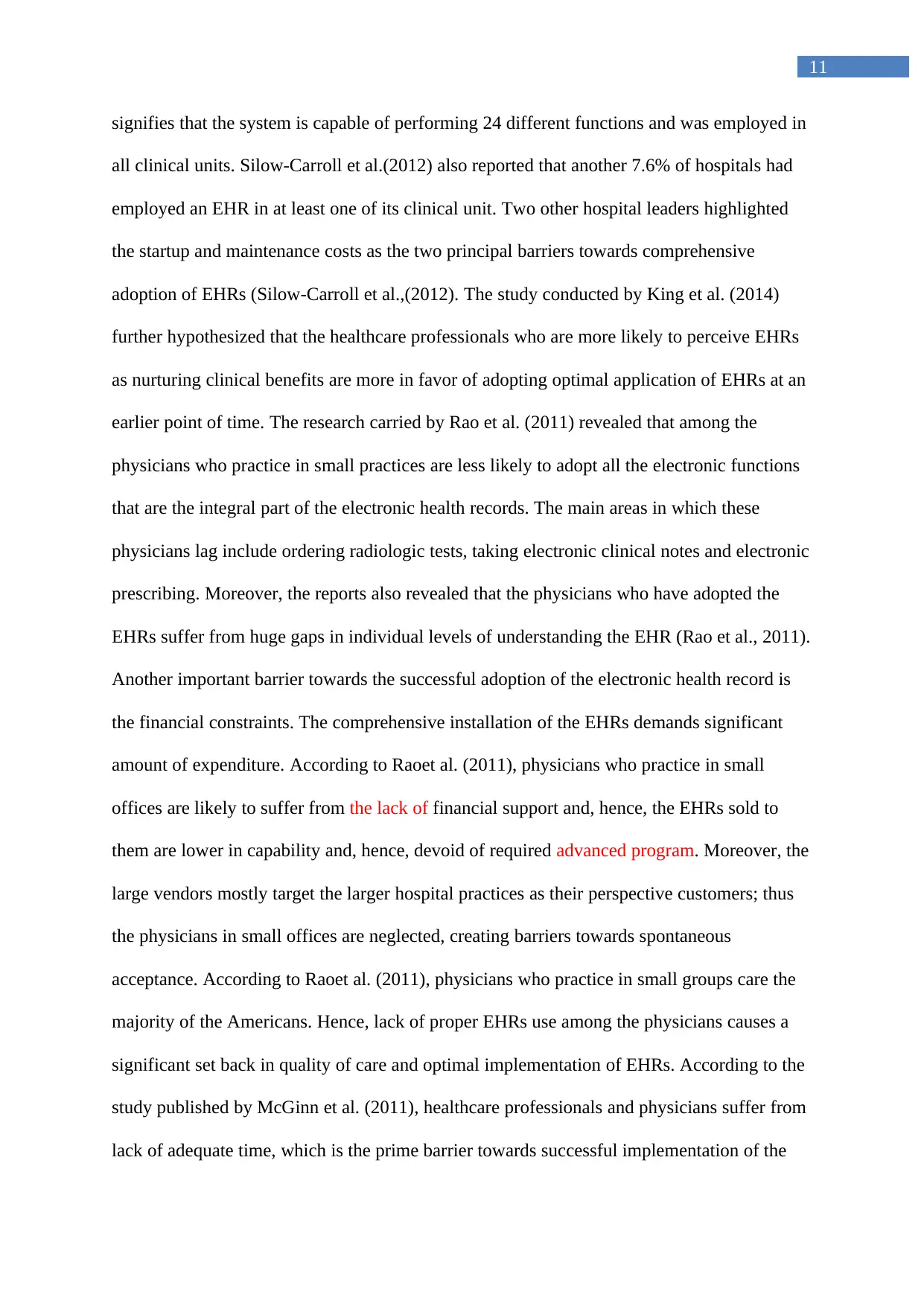
11
signifies that the system is capable of performing 24 different functions and was employed in
all clinical units. Silow-Carroll et al.(2012) also reported that another 7.6% of hospitals had
employed an EHR in at least one of its clinical unit. Two other hospital leaders highlighted
the startup and maintenance costs as the two principal barriers towards comprehensive
adoption of EHRs (Silow-Carroll et al.,(2012). The study conducted by King et al. (2014)
further hypothesized that the healthcare professionals who are more likely to perceive EHRs
as nurturing clinical benefits are more in favor of adopting optimal application of EHRs at an
earlier point of time. The research carried by Rao et al. (2011) revealed that among the
physicians who practice in small practices are less likely to adopt all the electronic functions
that are the integral part of the electronic health records. The main areas in which these
physicians lag include ordering radiologic tests, taking electronic clinical notes and electronic
prescribing. Moreover, the reports also revealed that the physicians who have adopted the
EHRs suffer from huge gaps in individual levels of understanding the EHR (Rao et al., 2011).
Another important barrier towards the successful adoption of the electronic health record is
the financial constraints. The comprehensive installation of the EHRs demands significant
amount of expenditure. According to Raoet al. (2011), physicians who practice in small
offices are likely to suffer from the lack of financial support and, hence, the EHRs sold to
them are lower in capability and, hence, devoid of required advanced program. Moreover, the
large vendors mostly target the larger hospital practices as their perspective customers; thus
the physicians in small offices are neglected, creating barriers towards spontaneous
acceptance. According to Raoet al. (2011), physicians who practice in small groups care the
majority of the Americans. Hence, lack of proper EHRs use among the physicians causes a
significant set back in quality of care and optimal implementation of EHRs. According to the
study published by McGinn et al. (2011), healthcare professionals and physicians suffer from
lack of adequate time, which is the prime barrier towards successful implementation of the
signifies that the system is capable of performing 24 different functions and was employed in
all clinical units. Silow-Carroll et al.(2012) also reported that another 7.6% of hospitals had
employed an EHR in at least one of its clinical unit. Two other hospital leaders highlighted
the startup and maintenance costs as the two principal barriers towards comprehensive
adoption of EHRs (Silow-Carroll et al.,(2012). The study conducted by King et al. (2014)
further hypothesized that the healthcare professionals who are more likely to perceive EHRs
as nurturing clinical benefits are more in favor of adopting optimal application of EHRs at an
earlier point of time. The research carried by Rao et al. (2011) revealed that among the
physicians who practice in small practices are less likely to adopt all the electronic functions
that are the integral part of the electronic health records. The main areas in which these
physicians lag include ordering radiologic tests, taking electronic clinical notes and electronic
prescribing. Moreover, the reports also revealed that the physicians who have adopted the
EHRs suffer from huge gaps in individual levels of understanding the EHR (Rao et al., 2011).
Another important barrier towards the successful adoption of the electronic health record is
the financial constraints. The comprehensive installation of the EHRs demands significant
amount of expenditure. According to Raoet al. (2011), physicians who practice in small
offices are likely to suffer from the lack of financial support and, hence, the EHRs sold to
them are lower in capability and, hence, devoid of required advanced program. Moreover, the
large vendors mostly target the larger hospital practices as their perspective customers; thus
the physicians in small offices are neglected, creating barriers towards spontaneous
acceptance. According to Raoet al. (2011), physicians who practice in small groups care the
majority of the Americans. Hence, lack of proper EHRs use among the physicians causes a
significant set back in quality of care and optimal implementation of EHRs. According to the
study published by McGinn et al. (2011), healthcare professionals and physicians suffer from
lack of adequate time, which is the prime barrier towards successful implementation of the
⊘ This is a preview!⊘
Do you want full access?
Subscribe today to unlock all pages.

Trusted by 1+ million students worldwide
1 out of 20
Related Documents
Your All-in-One AI-Powered Toolkit for Academic Success.
+13062052269
info@desklib.com
Available 24*7 on WhatsApp / Email
![[object Object]](/_next/static/media/star-bottom.7253800d.svg)
Unlock your academic potential
Copyright © 2020–2025 A2Z Services. All Rights Reserved. Developed and managed by ZUCOL.




